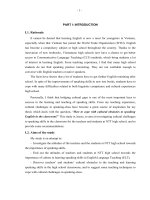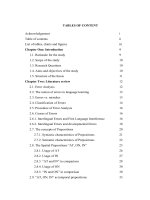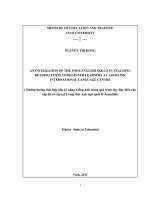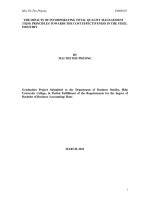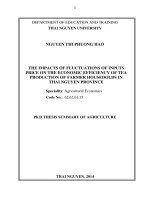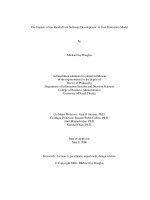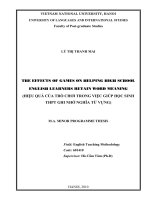the impacts of language games on vocabulary learning of young learners at my viet foreign language center
Bạn đang xem bản rút gọn của tài liệu. Xem và tải ngay bản đầy đủ của tài liệu tại đây (1.2 MB, 140 trang )
MINISTRY OF EDUCATION AND TRAINING
HO CHI MINH CITY OPEN UNIVERSITY
PHẠM DUY HẠNH
THE IMPACTS OF LANGUAGE GAMES ON VOCABULARY LEARNING
OF YOUNG LEARNERS AT MY-VIET FOREIGN LANGUAGE CENTER
MASTER OF ARTS IN TESOL
Ho Chi Minh City, 2019
MINISTRY OF EDUCATION AND TRAINING
HO CHI MINH CITY OPEN UNIVERSITY
PHẠM DUY HẠNH
THE IMPACTS OF LANGUAGE GAMES ON VOCABULARY LEARNING
OF YOUNG LEARNERS AT MY-VIET FOREIGN LANGUAGE CENTER
Major: Teaching English to speakers of other languages
Major code: 60140111
MASTER OF ARTS IN TESOL
Supervisor: Le Thi Thanh Thu, Ed. D.
Ho Chi Minh City, 2019
STATEMENT OF AUTHORSHIP
I certify that this thesis entitled “The Impacts of Language Games on
Vocabulary Learning of Young Learners at My-Viet Foreign Language Center” is
my own work.
Except where reference is made in the thesis, this thesis contains no material
published elsewhere or extracted in whole or in part from the other thesis.
No other person’s work has been used without the acknowledgement in the
main text of the thesis.
This thesis has not been submitted for the award of any degree or diploma in
any other tertiary institution.
Tien Giang Province, 2019
PHAM DUY HANH
I
ACKNOWLEDGEMENTS
I would like to express my deep thanks to the contribution of those who
supported me during the time I wrote this thesis. I cannot finish this study without
their help.
First and foremost, I would like to send my great gratitude to my supervisor,
Le Thi Thanh Thu, Ed. D, Dean of Postgraduate Education of Ho Chi Minh City
Open University, for all of her support during the time I have done this thesis. Her
useful advice helped me gain a lot of great knowledge to finish the thesis.
I am also thankful to Mr. Minh Tran Thien, the manager of My-Viet FLC
who created the best condition for me to conduct the experiment.
I also thank for the participant of all the learners for their enthusiastic in all
of the activities.
Lastly, I would like to send my gratitude to my family who motivated me to
finish this thesis.
II
ABSTRACT
The research was carried out at My-Viet Foreign Language Center (My-Viet
FLC) from May 12, 2018 to July 28, 2018. Two classes which the researcher is
teaching were conveniently chosen for this study as the experimental group (EG)
and the control group (CG). The research covered ten sub-units of Everybody Up 6
(Kampa & Vilina, 2012). The purpose of the study was to investigate the
effectiveness of applying language games in teaching English vocabulary to young
learners as compared to the current practice and the attitudes of the participants
towards the language games. The instruments were used to collect the data included
the tests for both groups and questionnaire for the EG. The results found from the
tests and the questionnaire were analyzed by using the mean score, the percentage
and T-Test.
The result from the tests showed that, at the beginning of the experiment,
there was no significant difference in the English proficiency between the two
groups. After the experiment, the EG got higher mean scores in comparison with
those of the CG. Because the same material was used to teach vocabulary for the
two groups and similar vocabulary teaching stages, the difference in the results
could be counted on the intervention of applying the language games. In addition,
the findings from the questionnaire demonstrated that young learners had a positive
attitude towards language games application. They strongly agreed that the
language games were beneficial for their vocabulary learning and even did not
consider what the educators warned as the disadvantages of the language games as
disadvantages at all.
The results of the study confirmed that language games could help My Viet
FLC young learners enhancing positive attitude towards studying vocabulary with
games and improve their vocabulary learning.
III
TÓM TẮT
Nghiên cứu được thực hiện tại Trung tâm ngoại ngữ Mỹ Việt (Mỹ-Việt FLC)
từ ngày 12 tháng 5 năm 2018 đến ngày 28 tháng 7 năm 2018. Hai lớp mà nhà
nghiên cứu đang giảng dạy đã được sử dụng như là một nhóm thực nghiệm và một
nhóm đối chứng cho nghiên cứu này. Nghiên cứu trải dài qua 10 bài học của quyển
Everybody Up 6 (Kampa & Vilina, 2012). Mục đích của nghiên cứu là để kiểm
chứng hiệu quả của việc áp dụng những trò chơi ngôn ngữ trong việc dạy từ vựng
Tiếng Anh cho những học viên nhỏ tuổi so với những phương pháp giảng dạy đang
được sử dụng hiện tại và thái độ của những người tham gia hướng tới các trò chơi
ngôn ngữ. Công cụ để thu thập dữ liệu bao gồm những bài kiểm tra cho hai nhóm
và bảng câu hỏi cho nhóm thực nghiệm. Kết quả tìm thấy được phân tích bằng cách
sử dụng điểm trung bình, tỉ lệ phần trăm và kiểm định T-Test.
Kết quả từ những bài kiểm tra đã chỉ ra rằng, trước thực nghiệm, không có sự
khác biệt đáng kể giữa hai nhóm về mức độ thành thạo Tiếng Anh. Sau thực
nghiệm, nhóm thực nghiệm đã đạt được những điểm trung bình cao hơn nhóm đối
chứng. Bởi vì cùng một tài liệu đã được sử dụng để dạy từ vựng cho hai nhóm và
các giai đoạn dạy từ vựng là tương tự, sự khác biệt trong những kết quả có thể được
giải thích bởi sự can thiệp của các trò chơi ngôn ngữ. Thêm nữa, những tìm thấy từ
bảng câu hỏi đã chứng tỏ rằng những học viên nhỏ tuổi có thái độ tích cực đối với
các trò chơi ngôn ngữ. Các em rất đồng ý rằng các trò chơi có nhiều ích lợi cho việc
học từ vựng của mình và thậm chí không xem xét những nhân tố được cho là bất lợi
của các trò chơi như là những bất lợi chút nào.
Những kết quả của nghiên cứu đã chứng thực rằng các trò chơi ngôn ngữ có
thể giúp cải tiến việc học từ vựng Tiếng Anh của những học viên nhỏ tuổi ở MỹViệt FLC cũng như các em đã có thái độ tích cực hướng tới việc học từ vựng với
các trò chơi.
IV
TABLE OF CONTENTS
STATEMENT OF AUTHORSHIP ..........................................................................i
ACKNOWLEDGEMENTS..................................................................................... ii
ABSTRACT ............................................................................................................. iii
TABLE OF CONTENTS.......................................................................................... v
LIST OF TABLES ...................................................................................................ix
LIST OF FIGURES .................................................................................................. x
ABBREVIATIONS ..................................................................................................xi
CHAPTER 1: INTRODUCTION ............................................................................ 1
1.1. Rationale for the study ............................................................................................. 1
1.2. Statement of the problem ......................................................................................... 2
1.3. Background of the study .......................................................................................... 3
1.3.1. My-Viet FLC ...................................................................................................... 3
1.3.2. The teachers........................................................................................................ 4
1.3.3. The learners ........................................................................................................ 4
1.3.4. Materials ............................................................................................................. 5
1.4. Objectives of the study and research questions ..................................................... 9
1.4.1. Objectives of the study ...................................................................................... 9
1.4.2. Research questions ............................................................................................. 9
1.5. Significance of the study ........................................................................................... 9
1.6. The scope of the study ............................................................................................ 10
1.7. Organization of the study ....................................................................................... 11
CHAPTER 2: LITERATURE REVIEW .............................................................. 12
2.1. YOUNG LEARNERS ............................................................................................. 12
2.1.1. Definitions of young learners .......................................................................... 12
2.1.2. Characteristics of young learners ................................................................... 12
2.2. VOCABULARY ...................................................................................................... 13
2.2.1. Definitions of vocabulary ................................................................................ 13
2.2.2. Different kinds of knowledge of a word ......................................................... 14
2.2.3. Types of vocabulary ......................................................................................... 16
V
2.2.4. The importance of vocabulary ........................................................................ 17
2.2.5. Vocabulary learning strategies ....................................................................... 19
2.2.5.1. Determination strategies........................................................................................... 19
2.2.5.2. Social strategies ........................................................................................................ 20
2.2.5.3. Memory strategies .................................................................................................... 20
2.2.5.4. Cognitive strategies .................................................................................................. 21
2.2.5.5. Metacognitive strategies........................................................................................... 21
2.2.5.6. Note-taking strategies............................................................................................... 22
2.2.5.7. Rote rehearsal strategies ........................................................................................... 22
2.2.5.8. Encoding strategies .................................................................................................. 23
2.2.6. How to learn vocabulary effectively ............................................................... 24
2.2.7. Process of teaching vocabulary ....................................................................... 26
2.2.7.1 Presentation ............................................................................................................... 26
2.2.7.2. Practice ..................................................................................................................... 27
2.2.7.3. Production ................................................................................................................ 28
2.2.7.4. Review ..................................................................................................................... 28
2.3. GAMES .................................................................................................................... 29
2.3.1. Definitions of games ......................................................................................... 29
2.3.2. Types of games ................................................................................................. 30
2.3.2.1. Guessing word games .............................................................................................. 31
2.3.2.2. Slap blackboard games ............................................................................................. 32
2.3.2.3. Hangman games ....................................................................................................... 33
2.3.2.4. Charade games ......................................................................................................... 34
2.3.3. Characteristics of language games ................................................................. 34
2.3.4. Benefits of using games.................................................................................... 35
2.3.5. Disadvantages of games ................................................................................... 37
2.3.6. When and how to use games ........................................................................... 38
2.4. ATTITUDES OF YOUNG LEARNERS TOWARDS TO THE GAMES......... 39
2.5. PREVIOUS STUDIES ............................................................................................ 40
2.5.1. Studies outside Vietnam .................................................................................. 40
2.5.2. Studies in Vietnam ........................................................................................... 43
2.5.3. Study gap .......................................................................................................... 44
CHAPTER 3: METHODOLOGY ......................................................................... 45
VI
3.1. Research site ............................................................................................................ 45
3.2. Research participants ............................................................................................. 45
3.3. Research design ....................................................................................................... 46
3.4. Language games applied in the experiment ......................................................... 49
3.5. Data collection instruments.................................................................................... 52
3.5.1. The tests ............................................................................................................ 52
3.5.1.1. Pre-test ..................................................................................................................... 52
3.5.1.2. Post-test 1 ................................................................................................................. 53
3.5.1.3. Post-test 2 ................................................................................................................. 53
3.5.1.4. Post-test 3 ................................................................................................................. 53
3.5.2. Questionnaire ................................................................................................... 54
3.6. Data analysis methodology ..................................................................................... 56
3.6.1. Tests................................................................................................................... 56
3.6.2. Questionnaire ................................................................................................... 57
CHAPTER IV: RESULTS AND DISCUSSIONS ................................................ 58
4.1. Pretest results of the EG and the CG .................................................................... 58
4.2. Posttest results of the CG ....................................................................................... 59
4.3. Posttest results of the EG ....................................................................................... 61
4.4. Posttests result comparison between the CG and the EG ................................... 63
4.5. Questionnaire results .............................................................................................. 68
4.5.1. The participants’ general feelings towards language games ....................... 69
4.5.2. The respondents’ reflections on the benefits of language games ................. 71
4.5.3. The participants’ attitudes towards the disadvantages of language games 77
CHAPTER V: CONCLUSIONS AND RECOMMENDATIONS ...................... 81
5.1. Conclusions .............................................................................................................. 81
5.2. Recommendations ................................................................................................... 83
5.2.1. For young learners ........................................................................................... 83
5.2.2. For the teachers ................................................................................................ 85
5.2.3. For My- Viet FLC managers .......................................................................... 86
5.3. Limitations of the study .......................................................................................... 87
5.4. Suggestion for further research ............................................................................. 88
REFERENCES ........................................................................................................ 89
VII
APPENDIX A. THE SAMPLE OF LESSON PLAN ........................................... 96
OF THE CONTROL GROUP AND THE EXPERIMENTAL GROUP ........... 96
APPENDIX B. THE PRE-TEST .........................................................................101
APPENDIX C. THE POST-TESTS ....................................................................102
APPENDIX D ........................................................................................................107
QUESTIONNAIRE IN ENGLISH VERSION ................................................... 107
APPENDIX E ........................................................................................................109
QUESTIONNAIRE IN VIETNAMESE VERSION ..........................................109
APPENDIX F: THE PRETEST RESULTS OF TWO GROUPS .................... 112
THE SCORES OF THE PRETEST OF THE CG .............................................112
APPENDIX G: THE POSTTEST RESULTS OF THE CG ............................. 115
APPENDIX H: THE POSTTEST RESULTS OF THE EG ............................. 117
APPENDIX I: POSTTESTS RESULT COMPARISON BETWEEN TWO
GROUPS ................................................................................................................119
APPENDIX J: PERSONAL INFORMATION OF THE PARTICIPANTS ...122
APPENDIX K: DATA OF THE ATTITUDES OF THE PARTICIPANTS
TOWARDS LANGUAGE GAME APPLICATION .........................................124
VIII
LIST OF TABLES
Table 3.1. The teaching activities for the CG and the EG.
Table 3.2. Game applied in the lessons of the EG.
Table 4.1. The pretest results.
Table 4.2. Posttest results of the CG.
Table 4.3. Posttest results of the EG.
Table 4.4. Posttest result comparisons between two groups.
Table 4.5. The participants’ general attitudes towards language game application.
Table 4.6. The benefits of games for learning new vocabulary.
Table 4.7. The participants’ attitudes towards the disadvantages of games.
IX
LIST OF FIGURES
Figure 4.1. Posttest results of the CG.
Figure 4.2. Posttest results of the EG.
Figure 4.3. The test results of two groups.
Figure 4.4. The personal information of the respondents.
Figure 4.5. Students’ perceptions of games’ benefits in learning vocabulary.
X
ABBREVIATIONS
CG
The control group
EG
The experimental group
M
Mean score
My-Viet FLC
My- Viet foreign language center
N
Number
p.
Page
Q
Question
SPSS
Statistical Package for the Social Sciences
XI
CHAPTER 1: INTRODUCTION
1.1. Rationale for the study
Young learners in English classes that the researcher is teaching cannot
remember new vocabulary well. They almost forget a significant number of new
words they learned after a few weeks. As a result, they did not perform well the
tests in class.
Although the researcher required them to repeat and write out new
vocabulary many times, the problem did not improved significantly. They still
cannot remember and write out the words correctly when required in the tests.
In terms of theory, to help children learn vocabulary effectively, classroom
environment must be fun and relaxed (Wharton, 2000), there are a lot of
oppoturnities for interaction (Key, 2004), vocabulary need to be repeated in
different ways (Brno, 2006), etc.
It seems that games could meet the above requirements. For example,
according to Azar (2012), the use of games in teaching vocabulary is one of the best
techniques to make the lessons more interesting and fun. In addition, Yuksek (2008)
realized that, when joining the games, learners had chances to repeat the same
vocabulary many times which helped them revise vocabulary in various ways. Last
but not least, Aslanabadi and Rasouli (2013) argued that, with games, the students
had opportunities to cooperate with their friends.
Therefore, the researcher decided to conduct this study, investigating the
effect of games on young learner's vocabulary learning, in comparison with the
current teaching techniques.
1
1.2. Statement of the problem
Teaching English in foreign language centers in Tien Giang province is quite
demanding for the teachers. When asked, my friends who are teaching English at
foreign language centers in Tien Giang such as Anh Viet, Tuong Lai and Au-Viet
Uc have revealed that they always try to improve their teaching quality. They
struggle to find out effective methods in order to help the learners to use English
confidently and successfully. However, the result is not as expected. The students
are still facing difficulties in learning vocabulary, which is considered as a difficult
aspect of English language for learners to master.
This is also the problem of the English teachers in My- Viet foreign language
center (My-Viet FLC). Many teachers at this center such as Thanh Tai Nguyen,
Nguyen Quynh Lien Le, Thanh Van Nguyen, etc had confessed that their main
concern was how to improve learners’ vocabulary. Various techniques in teaching
vocabulary have been applied including translation, synonyms, antonyms and
explanation. However, the learners, especially the young learners are still lack of
motivation to learn vocabulary effectively.
Among the solutions applied in this foreign language center, language games
had been proposed to the learners for a better achievement. There are different
reasons for that. First of all, language games can encourage young learners since
“people usually enjoy a task if they play an essential part in it” and that “games can
lower anxiety, thus making the acquisition of input more likely” (Yahoui, 2012,
p.2). In addition, it was said that “students retain 10 percent of what they read, 26
percent of what they hear, 30 percent of what they see, 50 percent of what they see
and hear, 70 percent of what they say, and 90 percent of what they say as they do
something” (Stice, 1987, as cited in Oyarzo, Vargas & Reyes, 2008, p.27).
Moreover, they are appropriate for use not only with the individuals but also with
2
the groups. Lastly, they can help to create a stress-free teaching environment. As a
result, the learners will prefer to study in an environment like that.
It seems that the current teaching and learning techniques are not quite
effective. As shared by the teachers as well as the researcher's observation and
practical teaching experience, teaching English vocabulary is usually done in a
stereotypical way which makes the students learn new vocabulary passively. As a
result, an alternative way should be introduced to help young learners be more
interested in learning new vocabulary and thus they could improve their vocabulary.
In order words, new techniques might be applied in the hope that they would
enhance the excitement in learning new English vocabulary of young learners. That
is the reason the researcher decided to take this study, trying to investigate the
impacts of games on vocabulary learning.
1.3. Background of the study
1.3.1. My-Viet FLC
The research was carried out at My-Viet FLC which is located at Go Cong
Town, Tien Giang Province. The center also has a branch in Go Cong Tay district
as well. This center is the one specializing in teaching English for young learners.
There are about 200 learners and 14 English teachers at the present. The age of the
learners is ranged from 6 to 12 years old. Located in the center of Go Cong town,
the center is a two-story building with 20 classrooms. The average number of the
learners per class is between 12 and 18 sitting in the rows of chairs facing the
blackboard. The classes are usually noisy because the young learners love playing
and chatting with each other. There are not so many foreign language centers
specializing for young learners on the spot. As a result, this is quite a popular
foreign language center in town.
3
The training programs at the center include Starter, Mover, Flyer, KET, PET
and English for Communication ones. Beside Vietnamese teachers, all English
classes at the center are also taught by native English speakers. The center’s
facilities are quite good. There are a board, a teacher’s desk, a fan, an air
conditioner, a screen, 20 to 25 chairs and the access to the Internet in every
classroom.
1.3.2. The teachers
The English teachers are competent with the appropriate professional
qualifications and teaching experience. They all have Bachelor-degrees in English
at least. Most of them are graduated from Can Tho and Tien Giang Universities.
Their age ranges from 25 to 35 years old. They usually are high school teachers in
town. They all have taught English in this center for about one year or above as a
part-time job. I observed that most of the English teachers in the center tend to rely
measurably on Grammar Translation Method and Audio - Lingual Method in their
teaching. They normally apply the same techniques when teaching new vocabulary
in the classrooms such as having the young learners write down, read aloud many
times and learn by heart the new vocabulary.
1.3.3. The learners
The learners come from My-Viet FLC neighborhood such as Go Cong Dong
district, Go Cong town and Go Cong Tay district. Most of them are young learners
who their age ranged from 6 to 12 years old. The teenagers and adult learners only
make a small proportion of all learners of English. As revealed from the teachers in
the center as well as from my practical teaching experience, the young learners are
most likely to come to English classes because their parents force them to do so. As
4
a result, the young learners tend to be passive in English classes. The English level
of young learners is of the beginner or pre-intermediate levels. As most of young
learners, unless activities are extremely engaging, young learners get easily bored,
losing interest after 20 or 30 minutes. Last but not least, they respond well to
praising for the works they did.
1.3.4. Materials
At the present, there are eight levels in the My-Viet FLC which are Starter,
Mover, Flyer, A1, A2, B1, B2 and English for communication. The center provides
six types of classes for the learners, namely Starter, Mover, Flyer, KET (A1 and A2
levels), PET (B1 and B2 levels) and English for communication.
Starter is an English course for the beginners. It uses Everybody Up 1 and 2
(Jackson & Sileci, 2012). They are popular teaching materials for young learners.
The components made up the course are a student book, a work book and an audiocassette. The books are fun and interesting designed to make young learners become
familiar with English language. It gives young learners a good foundation in
learning English by helping them acquires the vocabulary of basic topics (numbers,
country and nationality, personal information and so on) and becomes familiar with
the basic pronunciation, word stress, sentence intonation, basic grammatical points
such as articles, prepositions, modal verbs as well as the basic tenses in English.
Mover is the next level in the process of learning English for young learners.
Mover level uses Everybody Up 3 and 4 of the same authors. The components made
up the course are a student book, a work book and an audio-cassette. The books are
designed to help young learners understand basic instructions and basic information,
be able to complete basic sentence forms and write short paragraphs. From there, it
5
helps them develop confidence as well as build necessary language skills to be able
to engage in a real-world conversation on the certain topics.
Flyer is the next level in the process of learning English for young learners. It
uses Everybody Up 5 and 6 (Kampa & Vilina, 2012). The components made up the
course are a student book, a work book and an audio-cassette. The books are
designed to help children deal with everyday speaking and writing situations in
English at the basic level. They help young learners understand short messages and
simple verbal instructions, introduce themselves and answer basic questions about
personal information, interact with English speakers as they speak slowly and
clearly as well as write short and simple sentences. From there, the course helps
children develop confidence as well as build the language skills to communicate in
English in common situations in everyday life.
A1 and A2 levels (KET) use Cambridge English Prepare books which
include two levels. In detail, A1 level uses Cambridge English Prepare Level 1 and
A2 level uses Cambridge English Prepare Level 2 (Kosta & Williams, 2015). The
books have a lot of good and rich contents. The books are beautifully printed and
have a variety of color activities combined with multiple interactions. This teaching
material comprises a student book, a work book and an audio-cassette. The
purposes of the course are to engage young learners, build vocabulary range related
to many kinds of topics and develop four language skills, namely writing, listening,
reading and speaking skills. From there, the course aims to help young learners use
English naturally and confidently in their real life.
B1 level use Speak Now 1 (Richards & Bohlke, 2012). This teaching
material comprises a student book, a work book and videos. This course helps the
learners communicating with confidence. First of all, a speaking component in
every activity develops confident and successful speakers. In addition, practice part
6
offers the learners the extra opportunities to practice their speaking, including speak
and record pronunciation activities for them to grade and give individual feedback
on. Furthermore, videos illustrate useful everyday language. Last but not least,
review pages and testing materials enable learners to check their progress.
B2 level uses First Certificate Masterclass (Haines & Stewart, 2008) as the
main syllabus. There are twelve units in the Student book. The Student book
strongly focuses on vocabulary development, speaking skill and provides a writing
guide with examples, notes, and useful language for each type writing task. The
workbook provides extra skills-training exercises and practice for each of the 12
units in the Student Book. In a nutshell, the syllabus encourages the learners to be
independent persons, providing the opportunities for bringing their own experience
into their learning.
English for communication course uses Laser B1 (Mann & TayloreKnowles, 2013). It is a modern, fun and exciting course designed for teenagers or
adult learners. The course integrates development of all the language skills: reading,
writing, listening and speaking. A number of different components made up Laser
B1 course are Student book, Workbook and Audio CDs. There are 16 units in the
Student book. The Student Book reinforces the structures and vocabulary learnt in
each unit as well as focuses on topic-based lexis, collocations, word formation and
phrasal verbs. The Workbook follows the grammar, vocabulary, reading, listening
and writing syllabus of the Student book exactly and is designed for the learners to
further practice and consolidate the work done in the Student book. In addition, all
Workbook exercises are designed so that they can be assigned for homework.
Among the kinds of courses above, Starters, Movers, Flyers, A1 level and
A2 level are reserved mainly for children whereas B1 level, B2 level and English
for communication are for teenagers or adult learners. The teachers are required by
7
the Center to cover all the topics in the syllabus which include two books, namely
Student book and Workbook during the courses.
As to teaching of the first six levels, most teachers use Grammar-Translation
Method and Audio-Lingual Method in their teaching. Their common practice
convey the following main characteristics related to new vocabulary teaching and
learning process in the center. Firstly, imitation, repetition and memorization are the
main techniques that are employed. Secondly, the teachers usually try to cover all
new vocabulary in Student book and Work book in the allocated time in class. The
domination of teacher talk time is another characteristic in the classroom. In other
words, teachers talk most of the time when teaching new vocabulary. Thirdly, many
teachers believe that the learners’ errors must be corrected from the beginning. As a
result, the young learners have to repeat and imitate carefully the pronunciation of
all the new vocabulary their teacher have taught.
In addition, vocabulary teaching in most of the classes is done along with
teaching other parts. Vocabulary is taught at the beginning of a period of teaching.
The teacher follows the steps as presented below and this process usually takes
about 45 minutes. After that, young learners take a short break and continue to
study other areas. The goal of vocabulary teaching is to equip young learners the
necessary English vocabulary so that they can successfully complete the exercises
in the Workbook. Furthermore, mastering many vocabularies help young learners
pronounce English words better, therefore help them communicate better when
encountering situations that related to the topics that they had learned in the
classroom.
Besides that, the activities in teaching vocabulary usually follow the
following steps: the teacher firstly says “hello” with class and checks their
attendance. Then the teacher introduces new vocabulary on the whiteboard, reads
8
them aloud and gives the meanings by using synonyms, antonyms, translation and
explanation techniques. Also, young learners are required to repeat new vocabulary
and write down them in their notebooks. After that, the teacher asks the children to
do the exercises in Workbook to reinforce the new vocabulary learned. Next, the
teacher asks some learners to read or write down the new words. Finally, the teacher
again says pronunciation and meaning of these new words.
1.4. Objectives of the study and research questions
1.4.1. Objectives of the study
This study aimed at finding out the impacts of language games on
vocabulary learning of young learners in My-Viet FLC and investigating their
attitudes toward language game application.
1.4.2. Research questions
Based on the objectives mentioned above, the researcher attempted to find
out the answer via the following questions:
1. To what extent do language games affect young learners of My-Viet FLC
in learning new English vocabulary?
2. What are the attitudes of the young learners towards language game
application in learning new English vocabulary?
1.5. Significance of the study
Although the problem studied is not new to many researchers, the difference
lies in the reality of teaching. The study is expected to present a real situation in
9
which language games are applied in English classes for young learners in My-Viet
FLC, Go Cong Town, Tien Giang province. The researcher hopes that:
Theoretically, the finding of the study will give more information in teaching
English vocabulary with the games for young learners in My-Viet FLC.
Practically, the finding of the study can help to make the teachers in this
center more readily to use language games in teaching vocabulary as well as to
ensure academic success of My-Viet FLC. Also, this research also hopes to raise
awareness among the teachers and the students about positive correlation between
the language games and vocabulary learning in this context.
1.6. The scope of the study
First, the participants of this study were young learners who are studying
English at My-Viet FLC, Flyer class. Their age ranged from 7 to 10 years old.
Second, among four stages of the new vocabulary teaching activities, namely
presentation, practice, production and review, the language game application was
applied in the production stage. The first reason was that this was the most
important stage of all. The second reason was that the researcher realized that the
young learners in the English classes often lost their attention and became neglected
in their studies when the class came nearly to the end, i.e. the last 15 minutes games
were applied might attract their interest again to the lesson. In exploring the
vocabulary, this study also confined itself to the meaning and form of it.
10
1.7. Organization of the study
This research consists of five chapters. Chapter 1, the introduction, provided
background information of the study, statement of the problem and the purposes.
This chapter also discussed research questions, significance of the study, the scope
of the study and the overview of the study. Chapter 2 included the theoretical
information of the study and a review of related literature for the research. Chapter
3 described the research methodology employed for the research, which presented
the participants, research site, experiment and data collection instruments. Chapter 4
included the analyses of the data collected from the instruments, namely Pre-test,
Post-test 1, Post-test 2 and Post-test 3, and the questionnaire; then the finding
discussion. Chapter 5 discussed the main conclusions of the research, declared some
recommendations, limitations, and provided suggestions for further research.
11
CHAPTER 2: LITERATURE REVIEW
Chapter 1 overviewed the introduction for the study. This chapter
demonstrated the theoretical background of language games as one of the
recommended application to improve the vocabulary learning for the learners in
general and for young learners in particular. This chapter consisted of five main
parts, including the characteristics of young learners, an overview of vocabulary,
the concept of language games, the attitude of young learners towards to the games
and previous studies related to English vocabulary learning with the application of
language games.
2.1. YOUNG LEARNERS
2.1.1. Definitions of young learners
Young learners were defined by Scott and Ytreberg (1990) as the learners
whose ages ranged from five to ten or eleven years old. Cameron (2001) declared
that young learners have the age from five to twelve years old. In addition,
Kalendova (2008) stated that young learners are children from the first year of
formal schooling (five or six years old) to eleven or twelve years of age.
From the definitions above, we can conclude that the learners whose ages
range from five to twelve can be considered young learners.
2.1.2. Characteristics of young learners
The characteristics of young learners have also been addressed by many
scholars. According to Hallivell (1992), young learners are very good at interpreting
meaning without understanding all the words, can use limited language in a creative
12
